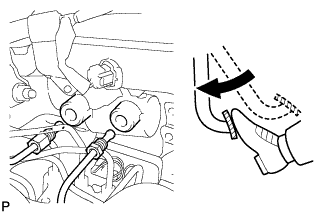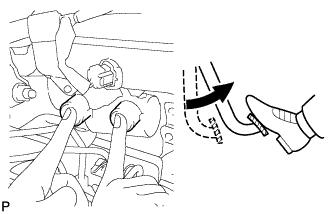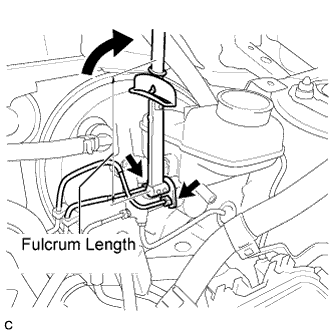Brake Fluid -- Bleeding |
- HINT:
- If any work is performed on the brake system or if air in the brake lines is suspected, bleed air from the brake system.
- NOTICE:
- Move the shift lever to P and apply the parking brake before bleeding the brakes.
- Add brake fluid to keep the level between the MIN and MAX lines of the reservoir while bleeding the brakes.
- If brake fluid leaks onto any painted surface, immediately wash it off.
| 1. REMOVE CENTER COWL TOP VENTILATOR LOUVER |
Slide the hood to cowl top seal and disengage the clip as shown in the illustration.
 |
Disengage the 5 claws and remove the center cowl top ventilator louver.
 |
| 2. FILL RESERVOIR WITH BRAKE FLUID |
Fill the reservoir with brake fluid.
- Brake Fluid:
- SAE J1703 or FMVSS No. 116 DOT 3
- NOTICE:
- Add brake fluid to keep the level between the MIN and MAX lines of the reservoir while bleeding the brakes.
| 3. BLEED BRAKE MASTER CYLINDER |
- NOTICE:
- If the master cylinder is reinstalled or if the reservoir becomes empty, bleed the master cylinder.
- To prevent brake fluid from damaging painted surface, cover any surrounding parts with a piece of cloth.
Using a union nut wrench (10 mm or 12 mm), disconnect the 2 brake lines from the master cylinder.
 |
Slowly depress the brake pedal and hold it*1.
 |
Cover the 2 outer holes with fingers, and release the brake pedal*2.
 |
Repeat *1 and *2 3 or 4 times.
Using a union nut wrench (10 mm or 12 mm), connect the 2 brake lines to the master cylinder.
- Torque:
- w/o VSC without a union nut wrench:
- 15 N*m{155 kgf*cm, 11 ft.*lbf}
- w/o VSC with a union nut wrench:
- 14 N*m{143 kgf*cm, 10 ft.*lbf}
- w/ VSC without a union nut wrench:
- 20 N*m{200 kgf*cm, 14 ft.*lbf}
- w/ VSC with a union nut wrench:
- 18 N*m{178 kgf*cm, 13 ft.*lbf}
- NOTICE:
- Use a torque wrench with a fulcrum length of 250 mm (9.84 in.).
- This torque value is effective when the union nut wrench is parallel to the torque wrench.
 |
| 4. BLEED BRAKE LINE |
- NOTICE:
- Bleed the brake line of the wheel farthest from the master cylinder first.
- Add brake fluid to keep the level between the MIN and MAX lines of the reservoir while bleeding the brakes.
Connect a vinyl tube to the bleeder plug.
Depress the brake pedal several times, and then loosen the bleeder plug with the pedal depressed*1.
When fluid stops coming out, tighten the bleeder plug, and then release the brake pedal*2.
Repeat *1 and *2 until all the air in the fluid is completely bled out.
Tighten the bleeder plug completely.
- Torque:
- Front bleeder plug:
- 8.3 N*m{85 kgf*cm, 73 in.*lbf}
- Rear bleeder plug (for Drum Brake):
- 8.5 N*m{87 kgf*cm, 75 in.*lbf}
- Rear bleeder plug (for Disc Brake):
- 10 N*m{102 kgf*cm, 7 ft.*lbf}
Repeat the above procedure for each wheel to bleed the brake line.
| 5. BLEED BRAKE ACTUATOR (w/ VSC) |
- NOTICE:
- After bleeding the brake system, if the specified height or feel of the brake pedal cannot be obtained, bleed the brake actuator assembly with the Techstream by following the procedure below.
Depress the brake pedal more than 20 times with the ignition switch off.
Connect the Techstream to the DLC3, and then turn the ignition switch to ON.
- NOTICE:
- Do not start the engine.
Turn the Techstream on and select "Air Bleeding" on the screen.
- NOTICE:
- Refer to the Techstream operator's manual for further details.
- Bleed air by following the steps displayed on the Techstream.
Bleed air according to "Step 1: Increase Line" on the Techstream display.
- NOTICE:
- Make sure that the master cylinder reservoir tank does not run out of brake fluid.
- Add brake fluid to keep the level between the MIN and MAX lines of the reservoir while bleeding the brakes.
Connect a vinyl tube to either one of the bleeder plugs.
Depress the brake pedal several times, and then loosen the bleeder plug connected to the vinyl tube with the pedal depressed*3.
When fluid stops coming out, tighten the bleeder plug, and then release the brake pedal*4.
Repeat *3 and *4 until all the air in the fluid is completely bled out.
Tighten the bleeder plug completely.
- Torque:
- Front bleeder plug:
- 8.3 N*m{85 kgf*cm, 73 in.*lbf}
- Rear bleeder plug (for Drum Brake):
- 8.5 N*m{87 kgf*cm, 75 in.*lbf}
- Rear bleeder plug (for Disc Brake):
- 10 N*m{102 kgf*cm, 7 ft.*lbf}
Repeat the above procedure for the rest of the wheels to bleed the brake lines.
Bleed the suction line according to "Step 2: Inhalation Line" on the Techstream display.
- NOTICE:
- Bleed the suction line by following the steps displayed on the Techstream.
- Add brake fluid to keep the level between the MIN and MAX lines of the reservoir while bleeding the brakes.
Connect a vinyl tube to the bleeder plug at the right front wheel or the right rear wheel and loosen the bleeder plug.
Operate the brake actuator assembly to bleed air using the Techstream*5.
- NOTICE:
- During this step, be sure to release the brake pedal.
- The actuator operation stops automatically in 4 seconds.
Check that the actuator operation has stopped by referring to the Techstream display, and tighten the bleeder plug*6.
Repeat *5 and *6 until all the air in the fluid is completely bled out.
Tighten the bleeder plug completely.
- Torque:
- Front bleeder plug:
- 8.3 N*m{85 kgf*cm, 73 in.*lbf}
- Rear bleeder plug (for Drum Brake):
- 8.5 N*m{87 kgf*cm, 75 in.*lbf}
- Rear bleeder plug (for Disc Brake):
- 10 N*m{102 kgf*cm, 7 ft.*lbf}
For the rest of the wheels, bleed air in the same way as stated in the above procedure.
Bleed the pressure reduction line according to "Step 3: Decrease Line" on the Techstream display.
- NOTICE:
- Bleed the pressure reduction line by following the steps displayed on the Techstream.
- Add brake fluid to keep the level between the MIN and MAX lines of the reservoir while bleeding the brakes.
Connect a vinyl tube to either one of the bleeder plugs.
Loosen the bleeder plug*7.
While keeping the brake pedal fully depressed, operate the brake actuator assembly using the Techstream.
- NOTICE:
- The actuator operation stops automatically in 4 seconds. When performing this procedure continuously, an interval of at least 20 seconds is required.
- After the operation is completed, the brake pedal goes down slightly. This is a normal phenomenon when the solenoid opens.
- During this procedure, the pedal seems heavy, but completely depress it so that the brake fluid comes out from the bleeder plug.
- Be sure to keep the brake pedal depressed. Never depress and release the pedal repeatedly.
Tighten the bleeder plug, and then release the brake pedal*8.
Repeat steps *7 to *8 until all the air in the fluid is completely bled out.
Tighten the bleeder plug completely.
- Torque:
- Front bleeder plug:
- 8.3 N*m{85 kgf*cm, 73 in.*lbf}
- Rear bleeder plug (for Drum Brake):
- 8.5 N*m{87 kgf*cm, 75 in.*lbf}
- Rear bleeder plug (for Disc Brake):
- 10 N*m{102 kgf*cm, 7 ft.*lbf}
Repeat the above procedure for the rest of the brakes to bleed the brake lines.
Bleed the brake lines again according to "Step 4: Increase Line" on the Techstream display.
- NOTICE:
- Bleed air by following the steps displayed on the Techstream.
- Add brake fluid to keep the level between the MIN and MAX lines of the reservoir while bleeding the brakes.
Connect a vinyl tube to either one of the bleeder plugs.
Depress the brake pedal several times, and then loosen the bleeder plug connected to the vinyl tube with the pedal depressed*9.
When fluid stops coming out, tighten the bleeder plug, and then release the brake pedal*10.
Repeat *9 and *10 until all the air in the fluid is completely bled out.
Tighten the bleeder plug completely.
- Torque:
- Front bleeder plug:
- 8.3 N*m{85 kgf*cm, 73 in.*lbf}
- Rear bleeder plug (for Drum Brake):
- 8.5 N*m{87 kgf*cm, 75 in.*lbf}
- Rear bleeder plug (for Disc Brake):
- 10 N*m{102 kgf*cm, 7 ft.*lbf}
Repeat the above procedure for each brake to bleed the brake lines.
Finish "Air Bleeding" on the Techstream, and then turn the Techstream off.
Disconnect the Techstream from the DLC3.
Turn the ignition switch off.
| 6. INSPECT FOR BRAKE FLUID LEAK |
| 7. INSPECT FLUID LEVEL |
Check the fluid level.
If brake fluid level is lower than the MIN line, check for leaks and inspect the disc brake pads. If necessary, refill the reservoir with brake fluid to the MAX line after repair or replacement.- Brake Fluid:
- SAE J1703 or FMVSS No. 116 DOT 3
 |
| 8. INSTALL CENTER COWL TOP VENTILATOR LOUVER |
Engage the 5 claws to install the center cowl top ventilator louver.
 |
Push and engage the clip, and slide and engage the claw of the hood to cowl top seal as shown in the illustration.
 |